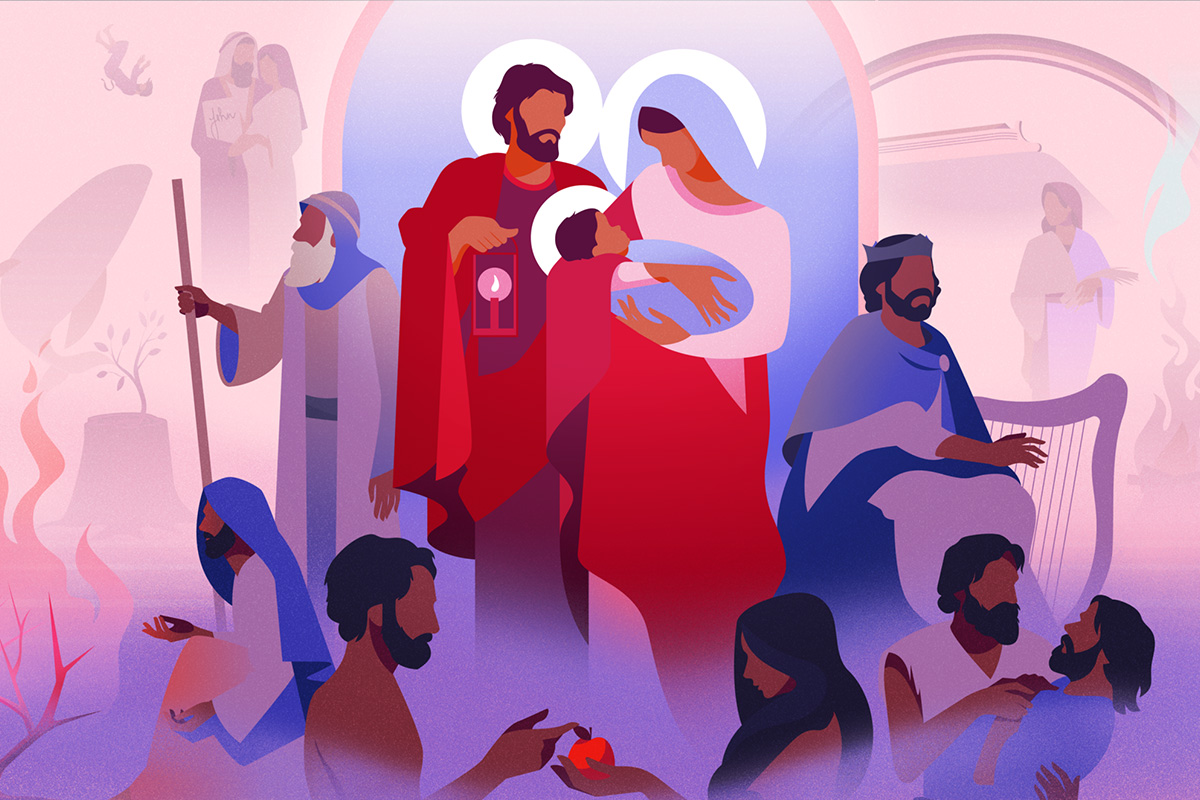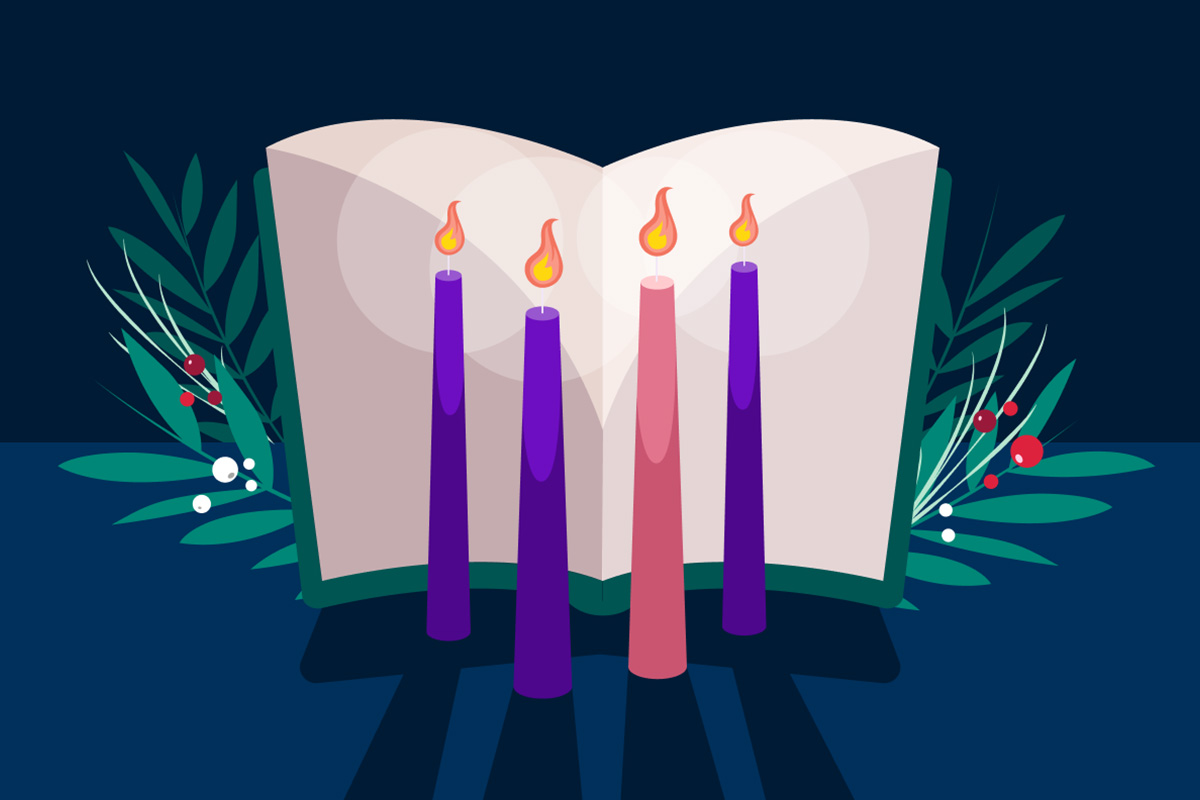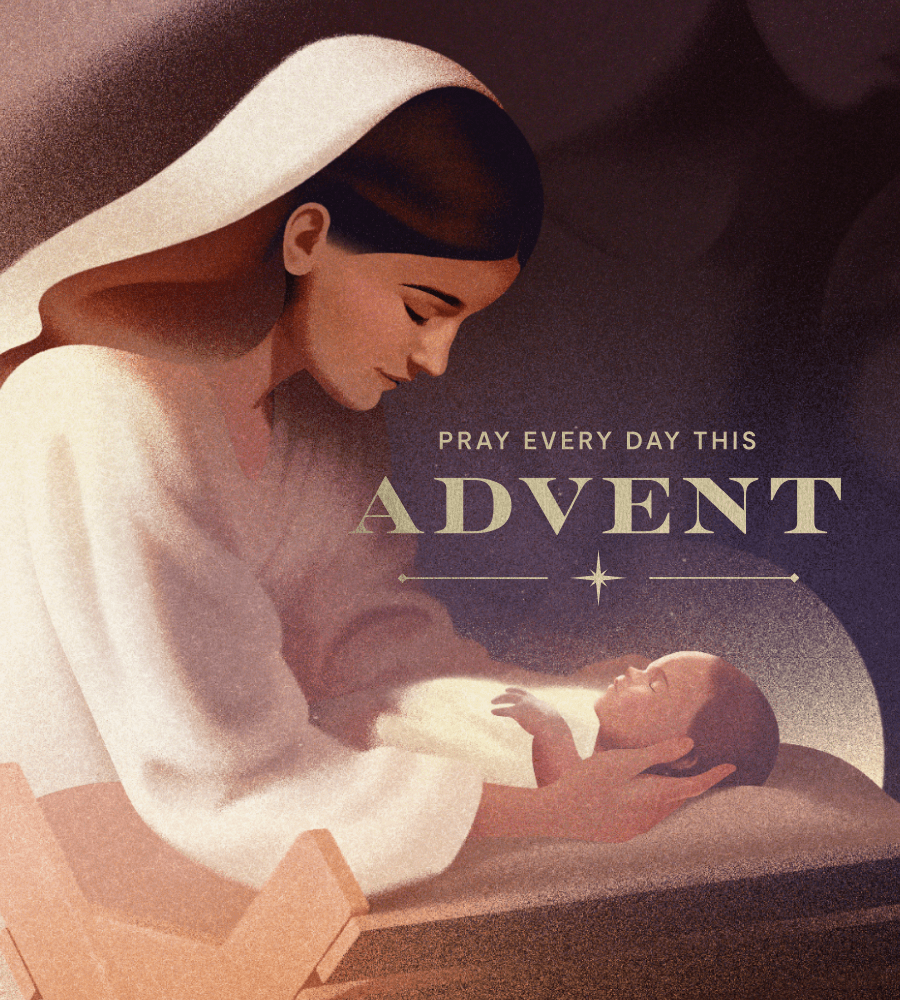Advent
Introduction
As the days get shorter in many parts of the world, we enter a season of waiting and preparation. This liturgical season is Advent, in which we eagerly await the birth of Jesus. It is also the first season of the new liturgical year. In Advent, we are renewed with anticipation of the birth of Jesus.
Christ the King.
Light of the World.
Son of God.
Prince of Peace.
King of Kings.
As St. (Pope) John Paul II said one First Sunday of Advent, “In Advent, we await an event which occurs in history and at the same time transcends it.”
The Season of Advent
Both Lent and Advent are seasons of waiting, preparation, and penance. During Lent, we await Christ’s return from 40 days in the desert, His loving sacrifice for us, and Resurrection. In Advent, we prepare for His birth. The birth and resurrection of Christ are intertwined, and their connection is quite significant theologically. Yet, these seasons of waiting look different for us – Advent is a uniquely joyous and hopeful season in the Church.
We light candles amidst the darkness. We find warmth in the cold, dark winter season. And we come together as friends and family to celebrate the coming of our Savior.
Advent is also the beginning of a new liturgical year. (This Advent season marks the start of Year C.)
We begin the year anew, renewed by His birth.
Advent: The Biblical Roots
Though it’s never explicitly mentioned in the Bible, Advent is inspired by scripture.
Isaiah, a messianic prophet, foretold Jesus’s birth centuries before it took place:
Therefore the Lord himself will give you a sign; the young woman, pregnant and about to bear a son, shall name him Emmanuel. (Isaiah 7:14)
In the Gospels, we see the fulfillment of this prophecy.
Now the birth of Jesus the Messiah took place in this way. When his mother Mary had been engaged to Joseph, but before they lived together, she was found to be with child from the Holy Spirit. Her husband Joseph, being a righteous man and unwilling to expose her to public disgrace, planned to dismiss her quietly. But just when he had resolved to do this, an angel of the Lord appeared to him in a dream and said, “Joseph, son of David, do not be afraid to take Mary as your wife, for the child conceived in her is from the Holy Spirit. She will bear a son, and you are to name him Jesus, for he will save his people from their sins.” All this took place to fulfill what had been spoken by the Lord through the prophet:
“Look, the virgin shall conceive and bear a son, and they shall name him Emmanuel,”
which means, “God is with us.” When Joseph awoke from sleep, he did as the angel of the Lord commanded him; he took her as his wife, but had no marital relations with her until she had borne a son; and he named him Jesus. (Matthew 1:18-25)
Hallow’s #Pray25 Advent community challenge guides you through this prophecy and its fulfillment. From the Garden of Eden to a manger in the small town of Bethlehem, we’ll reflect on God’s constant, loving call to humanity for generations to do His will, including His call on you.
The Four Sundays and Themes of Advent
From homes to churches, schools, and offices – the Advent wreath is a common symbol of the liturgical season. Its purpose is literally to light the way to the true Light of the World.
The circular wreath, typically made of evergreen leaves like pine or fir, represents God’s infinite and everlasting love for us. It also holds four candles to light each Sunday of Advent.
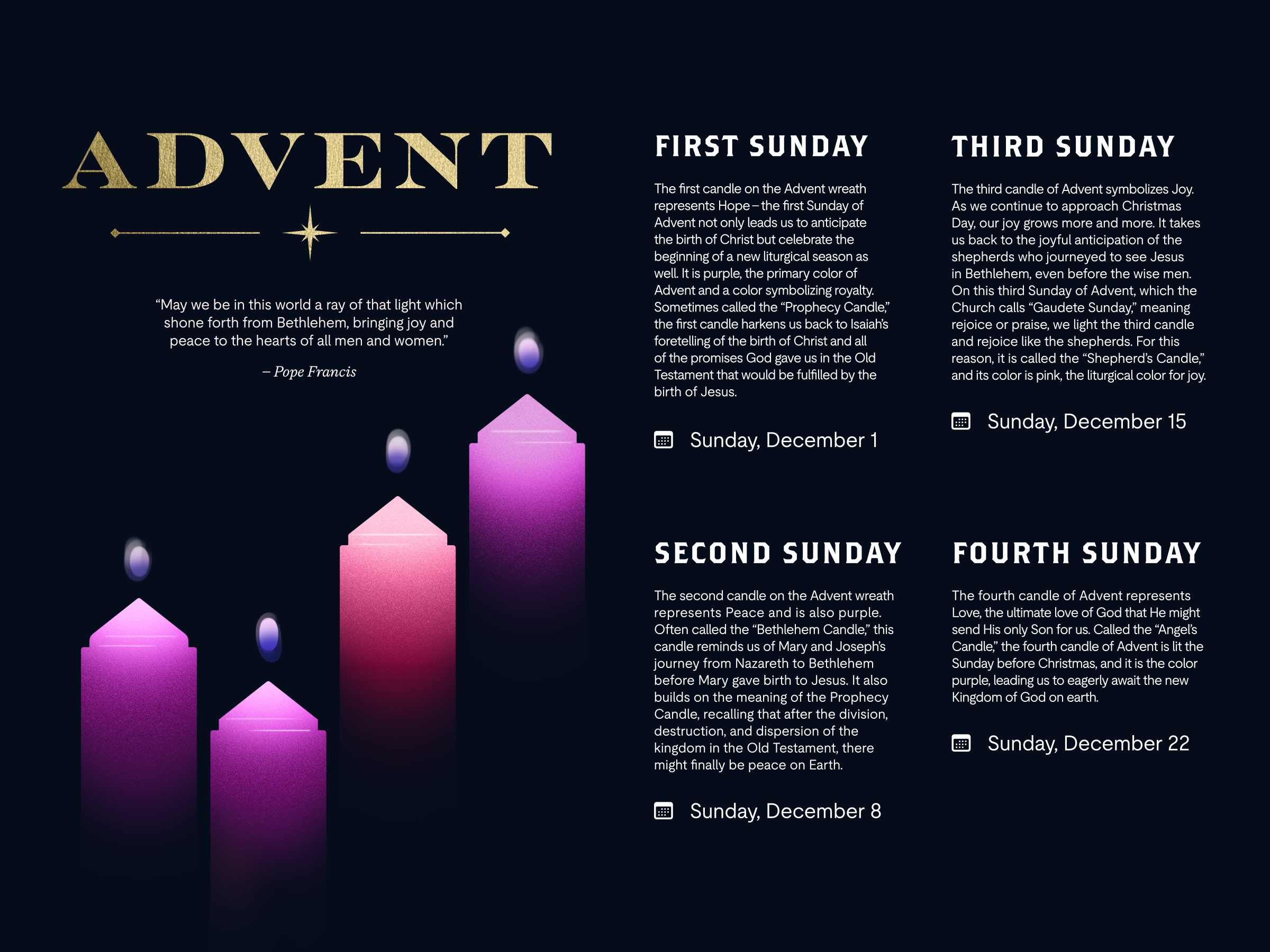
First candle / Sunday: HOPE (The Prophecy Candle)
Second candle / Sunday: PEACE (The Bethlehem Candle)
Third candle / Sunday: JOY (The Shepherd’s Candle)
Fourth candle / Sunday: LOVE (The Angel’s Candle)
READ MORE: Advent Wreaths & Candles
Advent Activities/Traditions
Cultures around the world celebrate Advent in a variety of ways. Many families will buy or build Nativity scenes for the home as visual reminders of this season of waiting and preparing for Jesus. Novenas, such as the St. Andrew Christmas Novena, are also popular globally.
Most of these traditions and activities center around hope, preparation, and celebration with friends and family.
SEE MORE: Advent Activities, Customs & Traditions
Advent Calendars
Advent calendars help keep us prayerful throughout Advent, reminding us of the reason behind the many festivities and parties that occur before Christmas. Seemingly more popular than ever before in the secular world, they remain overtly Christian and play a key role in preparing for the Nativity. You can find many Advent calendars online, including Hallow’s Advent 2024 Calendar below, or even create your own from paper or other materials.
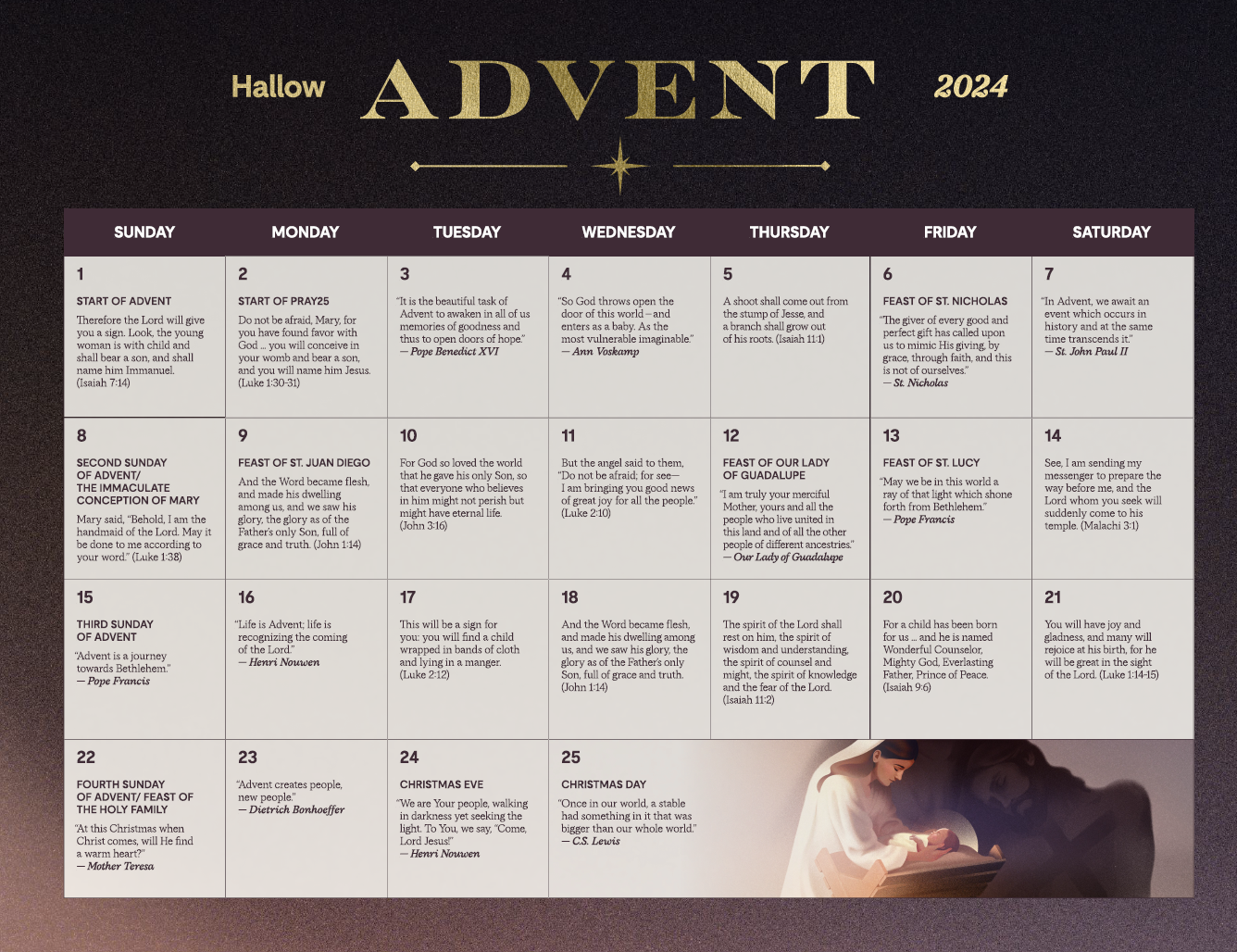
READ MORE: Advent Calendars 2024
Advent: The Beginning of a New Liturgical Year
Advent awakens us not only for the birth of Christ but also for the beginning of a new year in the Church. With Christ’s coming, we start anew – on the first Sunday of Advent, December 1, we’ll transition from cycle B to cycle C. Cycle A focuses on the Gospel of Luke, which we will hear during each Mass this Advent season.
SEE MORE: The Schedule of Advent
Like Lent, Advent is a season of preparation, repentance, and regality. The color purple liturgically represents these spiritual themes for both seasons. While they share the same liturgical color and many thematic similarities, our prayers and intentions vary in Lent and Advent. In Lent, we focus our meditation on the suffering of Christ’s 40 days in the desert leading up to His crucifixion and sacrifice of Love for us. In Advent, purple adorns churches as we await the coming of the true King.
The themes and lessons of Advent and Lent are most definitely related, illustrated by their sharing of the color purple, yet our prayer varies during these two seasons. The Scripture differs. And the homilies at Mass have a hopefulness that grounds them.
As Pope Benedict XVI said, “It is the beautiful task of Advent to awaken in all of us memories of goodness and thus to open doors of hope.”
Advent Prayers
It is this abounding hope that guides our prayer during the season of Advent. We pray to prepare our hearts to be like the manger in which Christ will soon lay – open and humble.
SEE MORE: Advent Prayers for 2024
We pray for patience, healing, transformation, and peace as our world, ravaged by war and turmoil, needs Jesus as much as ever this year.
Advent FAQ
What is Advent?
Advent is the liturgical season that precedes Christmas, during which Christians patiently and hopefully await the Nativity of the Lord.
What does the word “Advent” mean?
The word Advent comes from the Latin “adventus” meaning “a coming, approach, arrival.”
When does Advent start and end in 2024?
Advent starts on Sunday, December 1, 2024 and ends on Christmas.
When did Advent originate?
There is no known singular origin of Advent, though many traditions and practices of the earlier Church likely led to this liturgical season. Historians have suggested that Advent, in the way that we know it today, probably came about in the fifth or sixth century in Europe. In the ninth century, the Church designated the first Sunday of Advent as the beginning of the new liturgical year.
Who celebrates Advent?
Advent is largely celebrated by Christian churches that maintain a liturgical calendar, such as the Roman Catholic, Anglican, Lutheran, and Eastern Orthodox denominations.
What is the purpose of Advent? What does it represent?
The core purpose of Advent is maintained across the greater Church: to prepare our hearts for the coming of Christ. Advent manifests both inwardly, in our hearts, and outwardly, in our traditions and celebrations at Mass and at home.
How can I celebrate Advent?
Cultures worldwide celebrate Advent in various ways, yet most of these traditions and activities are grounded in hope and preparation for the coming of Jesus. Consider celebrating Advent with an Advent wreath and candles, an Advent calendar, or praying a novena.
What is an Advent wreath? What does it represent?
The Advent wreath is a centuries-old Christian tradition that holds four candles representing the four Sundays of Advent. The wreath’s circular shape and evergreen color represent God’s infinite and everlasting love for us.
What is the color of Advent? What does it represent?
Purple is the color of Advent; it represents preparation, repentance, and royalty as we hopefully await the coming of the true King, Jesus.
What prayers are said during Advent?
Advent prayers are centered around hope, joy, and renewal. During Advent, we pray for peace in our hearts and the world.

